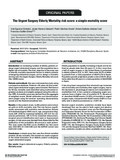Mostrar el registro sencillo del ítem
The urgent surgery elderly mortality risk score: a simple mortality score
| dc.creator | Eguaras Córdoba, Inés | es_ES |
| dc.creator | Herrera Cabezón, Javier | es_ES |
| dc.creator | Sánchez Acedo, Pablo | es_ES |
| dc.creator | Galbete Jiménez, Arkaitz | es_ES |
| dc.creator | Guillén Grima, Francisco | es_ES |
| dc.date.accessioned | 2020-03-20T08:50:49Z | |
| dc.date.available | 2020-03-20T08:50:49Z | |
| dc.date.issued | 2019 | |
| dc.identifier.issn | 1130-0108 | |
| dc.identifier.uri | https://hdl.handle.net/2454/36532 | |
| dc.description.abstract | Introduction: an increasing number of elderly patients undergo urgent abdominal surgery and this population has a higher risk of mortality.The main objective of the study was to identify mortality-associated factors in elderly patients undergoing abdominal surgery and to design a mortality scoring tool, the Urgent Surgery Elderly Mortality risk score (the USEM score). Patients and methods: this was a retrospective study using a prospective database. Patients > 65 years old that underwent urgent abdominal surgery were included. Risk factors for 30-day mortality were identified using multivariate regression analysis and weights assigned using the odds ratios (OR). A mortality score was derived from the aggregate of weighted scores. Model calibration and discrimination were judged using the receiver operating characteristics curves and the Hosmer-Lemeshow test. Results: in the present study, 4,255 patients were included with an 8.5% mortality rate. The risk factors significantly associated with mortality were American Society of Anesthesiologists (ASA) score, age, preoperative diagnosis (OR: 37.82 for intestinal ischemia, OR: 5.01 for colorectal perforation, OR: 6.73 for intestinal obstruction), surgical wound classification and open or laparoscopic surgery. A risk score was devised from these data for the estimation of the probability of survival in each patient. The area under the ROC curve (AUROC) for this score was 0.84 (95% CI: 0.82-0.86) and the AUROC correct was 0.83 (0.81-0.85). Conclusions: a simple score that uses five clinical variables predicts 30-day mortality. This model can assist surgeons in the initial evaluation of an elderly patient undergoing urgent abdominal surgery. | en |
| dc.format.extent | 6 p. | |
| dc.format.mimetype | application/pdf | en |
| dc.language.iso | eng | en |
| dc.publisher | Arán Ediciones | en |
| dc.relation.ispartof | Revista Española de Enfermedades Digestivas, 2019: 111 (9), 677-682 | es_ES |
| dc.rights | © Copyright 2019. SEPD y Arán Ediciones, S.L. | es |
| dc.subject | Urgent abdominal surgery | en |
| dc.subject | Elderly patients | en |
| dc.subject | Mortality score | en |
| dc.title | The urgent surgery elderly mortality risk score: a simple mortality score | en |
| dc.type | info:eu-repo/semantics/article | en |
| dc.type | Artículo / Artikulua | es |
| dc.contributor.department | Ciencias de la Salud | es_ES |
| dc.contributor.department | Osasun Zientziak | eu |
| dc.rights.accessRights | info:eu-repo/semantics/openAccess | en |
| dc.rights.accessRights | Acceso abierto / Sarbide irekia | es |
| dc.identifier.doi | 10.17235/reed.2019.6187/2019 | |
| dc.relation.publisherversion | https://doi.org/10.17235/reed.2019.6187/2019 | |
| dc.type.version | info:eu-repo/semantics/publishedVersion | en |
| dc.type.version | Versión publicada / Argitaratu den bertsioa | es |


